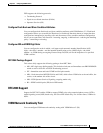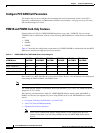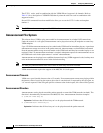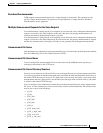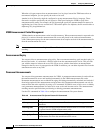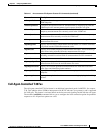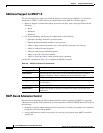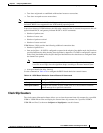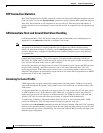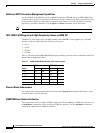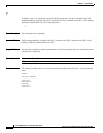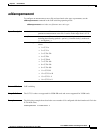
4-67
Cisco VISM Installation and Configuration Guide
Release 3.0, Part Number OL-2521-01 Rev. D0, June 2004
Chapter 4 Configuring VISM Features
Configuring Additional VISM Features
• Tear down originated or established unidirectional resource reservations.
• Tear down accepted resource reservations.
Note VISM supports RSVP in the VoIP switching operating mode only, with a 5 calls per second
limitation; RSVP is not supported in the VoIP trunking operating mode.
In previous releases of VISM software, the following connection data is returned in response to the call
agent initiated DLCX, and gateway initiated DLCX or AUCX commands:
• Number of packets sent
• Number of octets sent
• Number of packets received
• Number of octets received
VISM Release 3.0(0) provides the following additional connection data:
• Number of packets lost
• Inter-arrival jitter—If a DSP is configured to operate in the adaptive jitter buffer mode, the jitter data
provided indicates the delay that the jitter-algorithm is adapted to. If a DSP is configured to operate
in the fixed jitter buffer mode, the jitter data provided indicates the value that was configured when
the channel was opened.
Note For adaptive mode you can use the value to indicate that the configured initial delay value
is too low or too high, since the algorithm adapts according to the actual network jitter.
• Average transmission delay (latency)
Use the commands in Table 4-10 to configure the RSVP-based admission control feature.
Clock Slip Counters
The clock counter information feature allows you to clear the current frame slip counters for a specified
VISM or VISM-PR card line and display the current frame slip counters for a specified VISM or
VISM-PR card line. Use the new clrslipcnt and dspslipcnt to use this feature.
Table 4-10 RSVP-Based Admission Control Feature CLI Commands
Command Description
cnfrsvp Configures RSVP for a specified connection.
cnfrsvprefreshmiss Configures the number of times VISM waits for a missed RSVP minimum
refresh message for a specified connection.



